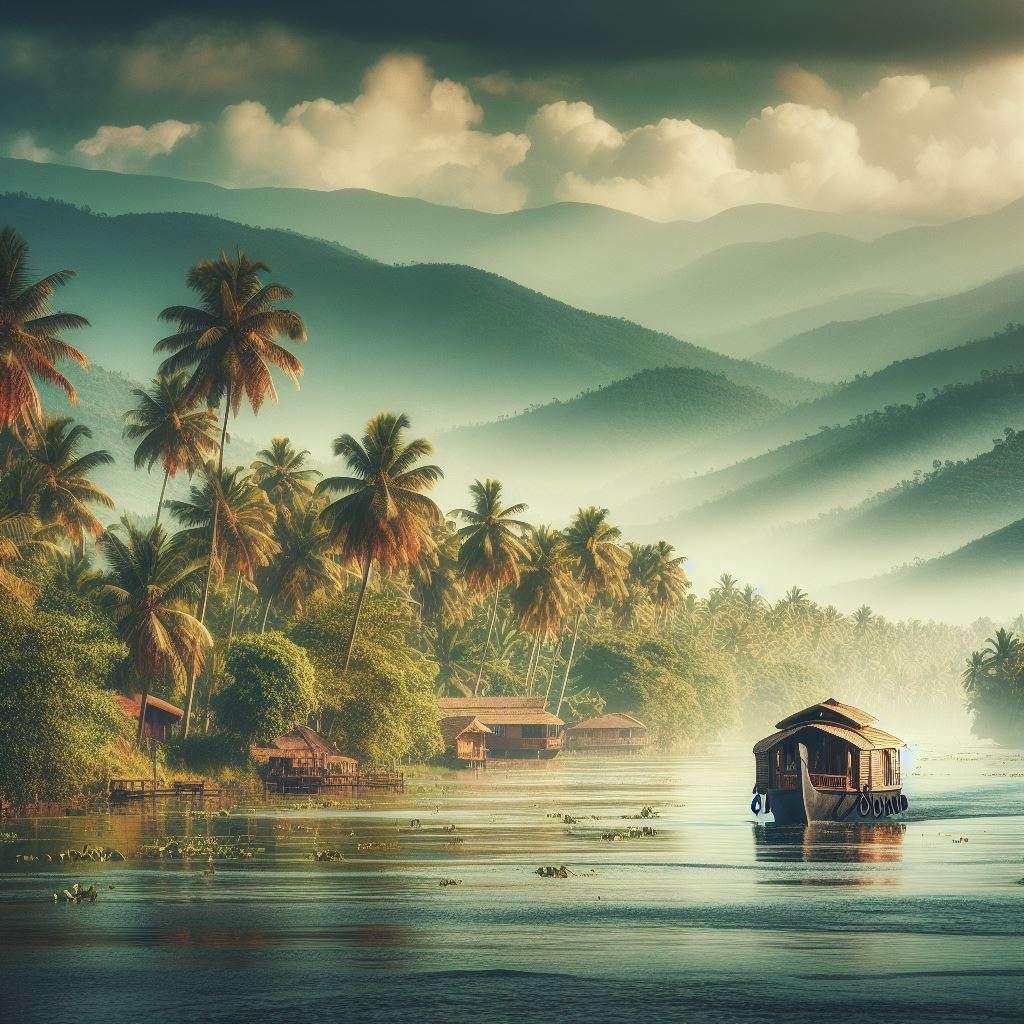Introduction to Kerala’s Climate
Kerala, located in the southwestern region of India, is renowned for its diverse and tropical climate. The state’s unique geographical features, such as its extensive coastline along the Arabian Sea and the towering Western Ghats, play a crucial role in shaping its weather patterns. Understanding Kerala’s climate is essential for planning the best time to visit this enchanting destination.
Kerala experiences three distinct seasons: summer, monsoon, and winter. The summer season, which spans from March to May, is characterized by hot and humid conditions. During this period, temperatures can soar, often reaching up to 35°C (95°F). Despite the heat, the coastal areas benefit from refreshing sea breezes, providing some respite from the intense temperatures.
The monsoon season in Kerala is a defining feature of its climate, commencing in June and lasting until September. The state receives heavy rainfall during this time, brought by the southwest monsoon winds. The Western Ghats act as a barrier, causing abundant precipitation on the windward side. This season transforms Kerala into a lush, green paradise, with its rivers, backwaters, and waterfalls brimming with life. However, the heavy rains can also lead to occasional flooding and travel disruptions.
Winter in Kerala, spanning from October to February, is considered the most pleasant season to visit. The temperatures during this period are mild, ranging from 20°C to 30°C (68°F to 86°F), making it ideal for outdoor activities and exploration. The humidity levels are also lower, providing a comfortable and enjoyable experience for travelers. The coastal regions and hill stations, such as Munnar and Wayanad, are particularly popular during the winter months.
In summary, Kerala’s climate is a blend of tropical warmth, abundant monsoon rains, and mild winters. Its diverse weather patterns, influenced by the coastline and the Western Ghats, offer a unique experience for visitors throughout the year. Understanding these seasonal variations is key to determining the best time to explore the natural beauty and cultural richness of Kerala.
Visiting Kerala During the Winter Season (October to February)
Winter season, spanning from October to February, is widely regarded as the optimal time for visiting Kerala. This period is marked by exceptionally pleasant weather, with temperatures ranging from a comfortable 10°C to 25°C. Such favorable climatic conditions make it ideal for a variety of outdoor activities and sightseeing adventures. The winter months in Kerala are a haven for tourists looking to experience the region’s natural beauty and cultural richness.
One of the primary attractions during the winter season is the array of vibrant festivals and events. The Kerala Boat Festival, also known as the Vallam Kali, is a spectacle of traditional boat races that capture the spirited culture of the state. Similarly, the Cochin Carnival, held every year in Fort Kochi, offers a blend of parades, games, and cultural performances that reflect the historical and cultural tapestry of Kerala. These events not only provide entertainment but also offer an immersive experience into the local traditions and festivities.
Winter is also the perfect time to explore Kerala’s renowned destinations. Munnar, with its rolling hills and tea plantations, becomes a picturesque retreat where visitors can enjoy trekking and nature walks. Thekkady, home to the Periyar Wildlife Sanctuary, offers a unique opportunity to witness wildlife in their natural habitat, along with activities like bamboo rafting and jungle safaris. Alleppey, often referred to as the “Venice of the East,” is especially enchanting during winter. The backwaters and houseboat cruises provide a serene and unforgettable experience, making it a must-visit destination.
In summary, the winter season in Kerala presents an ideal blend of pleasant weather, cultural festivities, and breathtaking landscapes. Whether it’s attending a lively festival, embarking on an outdoor adventure, or simply basking in the natural beauty, this time of year ensures a memorable and enriching visit to God’s Own Country.
Exploring Kerala in the Summer (March to May)
The summer season in Kerala, spanning from March to May, is marked by elevated temperatures, typically fluctuating between 29°C to 38°C. While the heat might be intense, this period presents a unique opportunity for those seeking a more tranquil and less crowded experience. The reduced influx of tourists means that visitors can explore Kerala’s natural beauty and cultural richness without the usual hustle and bustle.
One of the major attractions during the summer months is the hill stations, such as Wayanad and Munnar. These elevated regions offer a respite from the heat, with significantly cooler climates and breathtaking landscapes. Munnar, known for its sprawling tea plantations and mist-covered hills, is a haven for nature enthusiasts. Wayanad, with its lush forests, wildlife sanctuaries, and serene lakes, provides a perfect blend of adventure and relaxation.
Additionally, summer is an opportune time to experience the cultural vibrancy of Kerala. The Vishu festival, celebrated in April, marks the traditional New Year for Malayalees. The festival is characterized by elaborate feasts, vibrant decorations, and cultural performances, providing a deep dive into the local traditions and customs. Observing Vishu in Kerala offers a unique perspective on the state’s rich cultural heritage.
Moreover, the off-peak season means better deals on accommodation and travel, making it an economically viable option for budget-conscious travelers. The serene backwaters, unspoiled beaches, and tranquil villages are all the more enchanting when explored at a leisurely pace, away from the bustling crowds.
In essence, while the summer heat may be a consideration, the season offers a distinctive and serene experience for those willing to explore Kerala’s hill stations and immerse themselves in its cultural festivities. The unique blend of natural beauty and cultural richness makes a summer visit to Kerala a memorable endeavor.
The Monsoon Season (June to September) in Kerala
The monsoon season in Kerala, spanning from June to September, is marked by the arrival of the southwest monsoon, bringing with it heavy rainfall that transforms the region into a lush, green paradise. The intensity of the rainfall rejuvenates the landscapes, making it an ideal time for tourists who seek a serene and tranquil experience. The verdant hills, overflowing rivers, and vibrant backwaters create a picturesque setting that is unique to this time of year.
One of the key attractions during the monsoon season is the opportunity for Ayurvedic treatments. The high humidity and cool weather make the skin more receptive to herbal oils and therapies, which are believed to be more effective during this period. Several wellness centers and resorts across Kerala offer specialized monsoon packages that promise revitalization and relaxation, drawing visitors from around the world.
The monsoon season also coincides with significant cultural events in Kerala, most notably the festival of Onam. Celebrated with grand feasts, intricate flower carpets, traditional dances, and boat races, Onam offers a glimpse into the rich cultural heritage of the region. Participating in these festivities provides a unique and enriching experience for travelers, making their visit even more memorable.
However, the heavy rainfall can pose certain travel challenges. Road conditions may deteriorate, leading to potential delays and disruptions. It is crucial for travelers to plan their itineraries carefully, keeping in mind the weather forecasts and road advisories. Opting for reliable transportation services and ensuring accommodations in well-maintained establishments can help mitigate these issues.
In essence, the monsoon season in Kerala offers a blend of natural beauty, cultural richness, and wellness opportunities. While it requires careful planning, the rewards of experiencing Kerala in its rain-soaked splendor are well worth the effort.
Best Months for Specific Activities
Kerala, often referred to as “God’s Own Country,” offers a plethora of activities that can be enjoyed throughout the year. However, timing your visit to coincide with your interests can enhance your experience manifold. Here is a detailed guide on the best months to visit Kerala for various activities, ensuring you make the most out of your trip.
Backwater Cruises
The backwaters of Kerala are a unique network of lakes, canals, and rivers, offering a serene escape. The best time for a backwater cruise, especially in places like Alleppey and Kumarakom, is from October to February. During these months, the weather is pleasantly cool and dry, making it ideal for a houseboat stay. The lush greenery and the tranquil waters provide a picturesque setting, perfect for relaxation and photography.
Wildlife Safaris
If you are a wildlife enthusiast, visiting Kerala’s national parks and wildlife sanctuaries between November and January is recommended. Periyar Wildlife Sanctuary, located in Thekkady, offers excellent opportunities for wildlife spotting, including elephants, tigers, and various bird species. The dry season ensures better visibility and higher chances of encountering animals near water sources. Silent Valley National Park and Eravikulam National Park are also must-visit destinations during these months.
Beach Vacations
For those looking to unwind on Kerala’s pristine beaches, the period from December to March is ideal. Kovalam, Varkala, and Marari Beach are popular destinations, offering golden sands and azure waters. The weather during these months is perfect for sunbathing, swimming, and enjoying water sports. Additionally, beach resorts often host cultural performances and events, providing a blend of relaxation and entertainment.
Cultural Tours
Kerala’s rich cultural heritage can be best experienced from August to December. This period encompasses several traditional festivals such as Onam and Navaratri, which are celebrated with great fervor. Visiting places like Kochi, Thrissur, and Thiruvananthapuram during these months allows you to witness vibrant processions, traditional Kathakali performances, and temple festivals. The cooler weather also makes exploring historical sites and temples more comfortable.
By aligning your visit with these recommended months, you can tailor your Kerala experience to suit your interests, ensuring a memorable and fulfilling trip.
Festivals and Cultural Events to Experience
Kerala, often referred to as “God’s Own Country,” is renowned for its vibrant festivals and cultural events that encapsulate the state’s rich heritage. Among the myriad of celebrations, three stand out for their grandeur and significance: Onam, Thrissur Pooram, and the Nehru Trophy Boat Race.
Onam, celebrated in the Malayalam month of Chingam (August-September), is Kerala’s most revered festival. It marks the homecoming of the legendary King Mahabali and is characterized by elaborate feasts, traditional dances, and intricate flower carpets known as Pookalam. The festival spans ten days, with Thiruvonam being the most auspicious day. Visitors during Onam can partake in the Sadya, a sumptuous vegetarian banquet served on banana leaves, and witness the vibrant Pulikali (Tiger Dance) performances in Thrissur.
Thrissur Pooram, held in April or May, is one of the most spectacular temple festivals in Kerala. This grand event takes place at the Vadakkunnathan Temple in Thrissur and involves an awe-inspiring parade of caparisoned elephants, traditional drum performances, and a breathtaking display of fireworks. The highlight of Thrissur Pooram is the Kudamattom, where decorated umbrellas are exchanged in a rhythmic manner atop elephants. Attendees should arrive early to secure a good vantage point and be prepared for large crowds.
The Nehru Trophy Boat Race, held on the Punnamada Lake in Alappuzha on the second Saturday of August, is a thrilling spectacle of Kerala’s boat racing tradition. Known for its snake boats (Chundan Vallams) that can stretch over 100 feet and accommodate more than 100 rowers, the race is a fierce competition that draws both locals and tourists. To fully enjoy this event, it is advisable to book tickets in advance and consider staying in a houseboat for an immersive experience.
Attending these festivals provides a unique insight into Kerala’s cultural tapestry and offers unforgettable experiences. It is recommended to plan your visit around these events, ensuring you make necessary travel and accommodation arrangements well in advance to avoid any last-minute hassles.
Travel Tips for Visiting Kerala
Planning a trip to Kerala requires some forethought to ensure a smooth and enjoyable experience. One of the first considerations is what to pack. Since Kerala experiences a tropical climate, it’s crucial to bring lightweight, breathable clothing for most of the year. However, if you are visiting during the monsoon season (June to September), include waterproof gear such as a raincoat and water-resistant footwear. Sunscreen and insect repellent are essential items year-round.
When it comes to transportation, Kerala offers a variety of options. The state has a well-connected network of trains and buses, making it easy to travel between cities and towns. For a more comfortable ride, consider hiring a private taxi or using ride-sharing services, especially if you are traveling with family. Auto-rickshaws are convenient for shorter distances within cities. For an authentic experience, don’t miss a houseboat cruise on the backwaters, particularly in Alleppey.
Accommodation in Kerala ranges from budget-friendly hostels and guesthouses to luxurious resorts and homestays. For a unique experience, consider staying in a traditional houseboat or an eco-friendly resort. Always book accommodations in advance, particularly during peak tourist seasons from October to March.
Health and safety are paramount when traveling to Kerala. During the monsoon season, be cautious of slippery roads and potential flooding. It is advisable to drink bottled water and avoid street food to prevent any stomach issues. Make sure to have a basic first aid kit and any personal medications you might need. It’s also wise to consult your doctor about any necessary vaccinations before your trip.
Kerala is a culinary haven, offering a rich variety of local cuisine that should not be missed. Must-try dishes include the traditional Kerala Sadya, a vegetarian feast served on a banana leaf, and seafood delicacies like Karimeen Pollichathu (Pearl Spot Fish) and Chemmeen Curry (Prawn Curry). Don’t forget to sample the famous Kerala Parotta and appam with stew for a truly local experience.
Conclusion: Finding Your Perfect Time to Visit Kerala
In conclusion, determining the best time to visit Kerala hinges significantly on individual preferences and desired experiences. Kerala, with its diverse landscapes and rich cultural heritage, offers something unique in every season. For those looking to delve into cultural immersion, the vibrant festivals and pleasant weather from October to March make this period ideal. Adventure enthusiasts may find the monsoon season from June to September particularly appealing, as the landscapes transform into lush, verdant vistas, providing perfect conditions for activities like trekking and wildlife spotting.
If relaxation and wellness are your primary goals, the pre-monsoon period from April to May can be optimal. The Ayurvedic treatments are particularly effective during this time, offering rejuvenation and tranquility. Beach lovers and those seeking serene backwaters might consider the winter months when the weather is at its most favorable, offering a respite from the intense summer heat.
Ultimately, the best time to visit Kerala is subjective and should align with what you wish to gain from your journey. Whether you are captivated by Kerala’s cultural festivities, seeking adrenaline-pumping adventures, yearning for peaceful relaxation, or looking to undergo wellness therapies, Kerala’s seasonal diversity ensures that there is a perfect time for every traveler. Carefully consider your interests and plan accordingly to maximize your experience in God’s Own Country.
By assessing your personal preferences and the distinct offerings of each season, you can make an informed decision about when to visit Kerala, ensuring an enriching and memorable trip.




